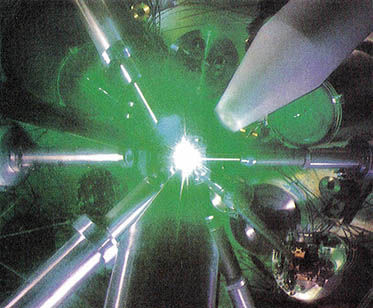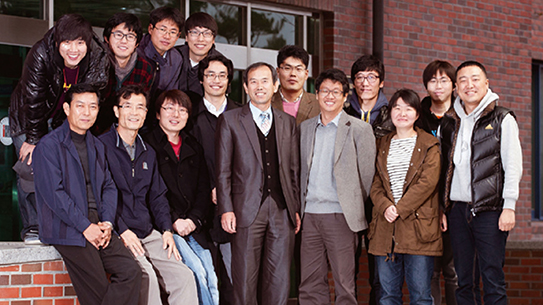지난 1987년 대마젤란 운(雲)내에는 엄청나게 큰 초신성이 있었다. 그리고 지난 1월 볼티모어에 위치한 우주망원과학연구소의 니노 파나글리아씨는 그 초신성이 우리가 지금까지 예측했던 것보다는 훨씬 정확하게 성운의 거리를 측정하게 해 주었다고 보고했다.
지금까지 마젤란운은 15만 광년 가량 떨어져 있는 것으로 추정돼 왔으나 이는 비교적 부정확한 수치이며 아마도 14~18만 광년 사이일 것으로 생각됐다.
거대한 폭발체인 초신성은 폭발 결과 대량의 먼지와 가스를 쏟아냈다. 이 먼지와 가스는 별 주변에 고리모양을 만들었으며 점차 뜨거워짐에 따라 자외선을 뿜어 탐지할 수 있게 됐다.
그 고리는 초신성의 자취와 지구를 연결한 가상평면으로부터 47˚기울어져 있다. 이는 우리가 그 고리를 평면인 원형모습이나 측면인 일직선으로 보지 못한다는 것을 의미한다. 즉 그 중간모습인 타원형을 보게 되는 것이다.
그 별의 (따라서 대마젤란운의) 거리를 측정하려면 두가지가 필요하다. 첫째는 마젤란운의 가시적인 직경이요, 둘째는 실제 직경을 아는 것이다.
가시적인 직경은 쉽게 구할 수 있다. 천체망원경으로 측정하기만 하면 된다. 그리고 그 답은 1.66초짜리 호로 밝혀졌다. 보름달이 1천 8백초의 호임을 고려할 때 이 정도의 가시적 크기는 별것이 아니다. 사실 1.66초의 호는 자동차의 두 전조등 사이를 1백 마일 밖에서 바라보았을 때의 분리정도와 흡사하다. 그럼에도 불구하고 천문학자들은 이 조그만 직경을 매우 정확하게 측정할 수 있다.
그렇다면 고리의 실제 직경은 어떻게 구할 수 있을까? 이는 고리가 지구와 가장 가까운 곳에서 나오는 빛이 지구에 닿는 시간과 가장 먼 곳에서 나오는 빛이 닿는 시간을 비교하면 된다.
초신성의 기록을 검토한 결과, 고리의 가장 가까운 끝부분으로부터 빛이 우리에게 도달한 것은 초신성의 폭발이후 80일이 지나서였음이 판명됐다. 또한 고리의 가장 먼 부분으로부터의 빛이 우리에게 도달한 것은 폭발이후 3백40일이 지나서였다.
그 고리가 약간 비스듬하다는 것과 초신성의 폭발후 그 고리가 점차 팽창한 속도를 고려했을때, 천문학자들은 이것의 실제직경이 1.37광년임을(약 8조마일) 계산해 낼 수 있었다. 이제 천문학자들은 질문을 해야했다. 고리가 얼마나 떨어져 있기에 1.37광년의 직경이 우리에게는 1.66초폭의 호로 보이는가?
그 답은 16만 9천 광년으로 이는 대마젤란운의 모든 수많은 별들의 평균거리로 받아들여지고 있다. 이는 꽤나 만족스러운 답인 것이, 바로 과거에 추정했던 거리예측치와 제법 정확하게 맞아 떨어지기 때문이다.
거대한 대마젤란운의 거리 그 자체가 중요한 것은 아니다. 여기엔 보다 중요한 사연이 있음을 알아야 한다.
지난 60여년동안 천문학자들은 우주가 얼마나 크고 얼마나 빨리 확장하고 있으며, 따라서 대폭발이 얼마나 오래전에 있었고 우주의 나이가 얼마인지를 계산코자 노력해 왔다.
그 방법이란 우리와 꽤 가까운 대상물로부터 시작하여 떨어져있는 다른 물체까지의 거리를 측정하고, 그 후 그 물체로부터 좀 더 떨어져있는 물체까지의 거리를 측정하는 것 등이었다.
그러나 문제는 한 물체집단으로부터 다른 집단까지의 거리를 측정함에 있어 천문학자들은 정확한 가정을 세워야함에도 그들은 그 가정이 얼마나 정확한지에 대해 전혀 확신할 수 없다는 것이다. 그 결과, 지구로부터 멀리 떨어져 있을수록 그 측정된 거리는 부정확하며 우주의 확장속도및 나이 역시 마찬가지라는 것이다.
현재 우주의 나이는 흔히 1백50억년쯤 되는것으로 이야기되고 있지만 아무도 이를 자신있게 말하지는 못한다. 1백억년 밖에 안될 수도 있고 2백억년 가까이로 갈 수도 있다. 사실 최근 연구 결과는 은하수는 매우 거대한 덩어리 상태로 존재하는데, 2백억년이란 세월조차도 그와같은 덩어리를 형성하는데 충분한 시간이 아니라는 것을 밝히고 있다.
그러나 이제 대마젤란운의 거리와 관련된 비교적 정확한 수치를 가지고 우리는 보다 좋은 출발점에서 다시 계산을 거듭해 볼 수 있게 됐다.
끊임없이 그 정밀도가 높아져온 천문학용 기계들과 함께 이것은 보다 정확하게 머나먼 은하수들의 거리를 측정할 수 있도록 할 것이며 우주의 나이에 관한 보다 정확한 수치가 제시됨으로써 우리는 보다 정확하게 어떻게 은하계가 형성되고 뭉쳐졌는가를 알 수 있게 될 것이다.
따라서 지난 1987년의 초신성은 천문학자들에게 전혀 기대하지 않았던 기막힌 보너스를 제공한 셈이다.
Back in 1987, there was a gigantic supernova in the Large Magellanic Cloud. That supernova yielded a measure of the cloud's distance that is more accurate than any we have ever had before, Nino Panaglia of the Space Telescope Science Institute in Baltimore reported in January.
Until now, it was estimated that the Large Magellanic Cloud was about 150,000 light-years away, but this was a rather rough figure and the possibility was that it might be as close as 140,000 light-years away, or as far as 180,000 light-years away.
As a result of the supernova, which is a gigantic exploding star, a vast amount of dust and gas was hurled out of the star. This dust and gas formed a ring about the star, and as it heated up, it gave off ultraviolet light so that it could be detected.
The ring is tilted at 47 degrees to the imaginary plane that connects the remnant of the supernova with the earth. That means we don't see it broadside as a circle, or edgewise as a line. We see it in between- as an ellipse.
Now in order to determine the distance of the star (and therefore of the Large Magellanic Cloud) two things are necessary. First, we have to know the apparent diameter of the cloud, and second we have to know its real diameter.
The apparent diameter is easy. It just has to be measured in the telescope. It turns out to be 1.66 seconds of arc. This is not much of an apparent size since the full moon is something like 1,800 seconds of arc across. In fact, a diameter of 1.66 seconds of arc is something like the separation between two auto headlights viewed at a distance of a hundred miles. Nevertheless, this tiny diameter can be measured quite accurately by astronomers.
But how do you go about determining the real diameter of the ring? This is done by comparing the length of time it takes light to reach earth from the nearest portion of the ring with the time it takes from the farthest portion.
In studying the records of the supernova, it turned out that light from the near end of the ring first reached us 80 days after the supernova explosion. The light from the far end of the ring didn't reach us till 340 days after the supernova explosion.
Allowing for the tilt of the ring, and the rate at which the ring has been expanding since the days of the supernova explosion, astronomers are able to determine that its real diameter is 1.37 light-years (nearly 8 trillion miles.) Now astronomers had to ask the question: How far must the ring be so that a real diameter of 1.37 light-years appears to us to represent a width of 1.66 seconds of arc?
The answer comes out 169,000 light-years, which can now be taken as the distance, on the average, of all the billions of stars in the Large Magellanic Cloud. This is rather gratifying, for it comes out fairly close to the crude approximations of the distance made in earlier times.
Nor is the distance of the Large Magellanic Cloud important just for it's own sake. There is much more to it than that.
For the last 60 years or so, astronomers have been trying to determine the size of the universe, how fast it is expanding, and therefore, how long ago the Big Bang took place and how old the universe might be.
The way to do that is to start with objects that are fairly close to us, and then try to estimate from that how far other more distant objects are, and from that the distance of still farther objects, and so on.
The trouble is that in going from one set of objects to another more distant set, astronomers have to make certain assumptions and they can never be sure how nearly right those assumptions might be. In consequence, the farther out they go from earth, the more uncertain they are about distance, and about the rate of expansion and about the age of the universe.
Right now, the age of the universe is usually said to be 15 billion years, but that is by no means certain. It could be as little as 10 billion years and as much as 20 billion. In fact, recent studies have shown that galaxies exist in such large clumps that even 20 billion years may not offer enough time for those clumps to form.
Now, though with a reasonably exact figure for the distance of the Large Magellanic Cloud, we can work our way outward with a better starting point.
That, together with the steadily increasing sophistication of astronomical instruments, may make it possible to get better figure for the distance of far-off galaxies, and, by giving us a determine more exactly how galaxies form and clump together.
The supernova of 1987 has thus offered astronomers as remarkable bonus-one that came quite unexpectedly.
(c) 1991. Los Angeles Times Syndicate
이 기사의 내용이 궁금하신가요?
기사 전문을 보시려면500(500원)이 필요합니다.
1991년 05월 과학동아 정보
🎓️ 진로 추천
- 천문학
- 물리학
- 지구과학

















